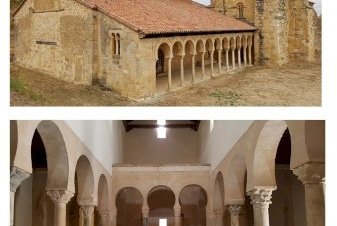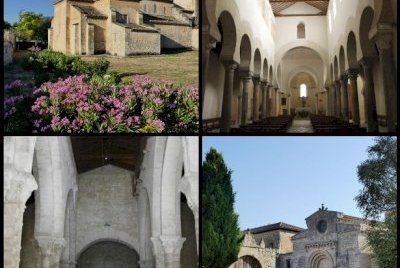Spain
Group of Mozarabic buildings on Iberian Peninsula
The group of Mozarabic buildings consists of ten pre-Romanesque churches and monasteries in northern and central Spain, dating from the late 8th century to the mid-11th century. Mozarabs were Iberian Christians who lived under Muslim rule in the Middle Ages and adopted elements of Arab culture. The Mozarabic architectural style is characterized by the assimilation of Islamic motifs like horseshoe arches, alfiz frames and the use of pillars and columns.
Site Info
Official Information
- Full Name
- Group of Mozarabic buildings on the Iberian Peninsula (ID: 6377)
- Country
- Spain
- Status
-
On tentative list 2019
Site history
History of Group of Mozarabic buildings on Iberian Peninsula
- 2019: Added to Tentative List
- Added to tentative list
- Type
- Cultural
- Criteria
Links
- UNESCO
- whc.unesco.org
All Links
UNESCO.org
- whc.unesco.org — whc.unesco.org
Community Information
- Community Category
- Religious structure: Christian
Travel Information
Recent Connections
News
No news.
Recent Visitors
Visitors of Group of Mozarabic buildings on Iberian Peninsula
- Adolfo
- Alexander Lehmann
- Argo
- bossc
- Carlos Sotelo
- Caspar
- Christoph
- Christravelblog
- Clyde
- David Berlanda
- Errol Neo
- GeorgeIng61
- Hubert
- Jan-Willem
- Jasam
- Javier Coro
- Jonas Kremer
- Lisu Marian
- Mathijs
- M. Huineman
- Persian Globetrotter
- Randi Thomsen
- Roman Bruehwiler
- scubarrie
- Sergio Arjona
- Svein Elias
- Thomas Buechler
- usagi1974
- voyager
Community Reviews
Show full reviewsArgo
Group of Mozarabic buildings on Iberian Peninsula
Group of Mozarabic buildings on Iberian Peninsula (On tentative list)

We have so far visited four of the buildings of this TWHS, scattered across Spain. Visigoths ruled Iberia after the collapse of the Roman Empire; they converted to Christianity and developed their own art and architecture, incorporating elements from Rome and Byzance. During the 8th century, Muslim Arabs took most of the peninsula, with independent Christian kingdom surviving only in the northernmost area (Asturias). Christians who stayed and lived in the Arabic kingdom were called “Mozarabes”. During the 10th century, Christians started to take back control of Spain, moving from north to south. In these newly (re) conquered territories, they built churches and monasteries combining all these different styles – for example, they had an extensive use of horseshoe arches and alfiz (the “frame” around the arch), already famous from Cordoba Mosque, mixed with symbols commonly used by Visigoths (birds, plants) and technics from Romans (basilical layout of the buildings, columns, etc). Some Mozarabes also moved northward as conditions for Christians became more difficult in the Arabic caliphate, and this contributed to an even bigger exchange of traditions and art between the different states.
San Miguel de Celanova was built as a private chapel next to a monastery. That’s a tiny building from mid of 10th century, and this is probably what saved it: the monastery grew and was rebuild at different times, but the chapel remained intact in the backyards. It is claimed to be the only totally intact “mozarabic” building in Spain, hence its great importance. From …
Keep reading 0 commentsClyde
Group of Mozarabic buildings on Iberian Peninsula
Group of Mozarabic buildings on Iberian Peninsula (On tentative list)

In July 2020 I visited 2 locations of this tentative WHS, namely the Mozarabic Church of San Cipriano in Cebrian de Mazote (top photos) and the Mozarabic Church/Ossuary of Santa Maria in Wamba (bottom photos), both close to Valladolid. Something worth keeping in mind when visiting is that both are closed on Mondays.
The Mozarabs were the Iberian Christians who lived under Moorish rule in Al-Andalus. Although their descendants remained unconverted to Islam, they were mostly fluent in Arabic and adopted elements of Arabic culture. The local Romance vernaculars, heavily permeated by Arabic and spoken by Christians and Muslims alike, have also come to be known as the Mozarabic language. Most of the Mozarabs were descendants of Hispanic Christians and were primarily speakers of Mozarabic (late Latin of Iberia) under Islamic rule. They also included those members of the former Visigothic ruling elite who did not convert to Islam or emigrate northwards after the Muslim conquest. Spanish Christians initially portrayed Muslims primarily as military or political enemies, but with time, Islam came to be seen as a religion and not merely a threat.
The Mozarabs of Muslim origin were descendants of those Muslims who converted to Christianity following the conquest of Toledo, and perhaps also following the expeditions of King Alfonso I of Aragon. When comparing this tWHS to the already inscribed Mudejar architecture it is worth mentioning that the Mozarabs of Muslim origin who converted en masse at the end of the 11th century are totally distinct …
Keep reading 0 comments
